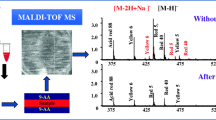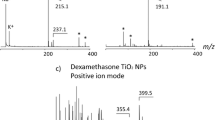Abstract
Matrix-assisted laser desorption/ionization time-of-flight mass spectrometry (MALDI–TOF MS) has been proved to be a powerful tool for the identification and characterization of microorganisms based on their surface peptide/protein pattern. Because of the complexity of microorganisms, there are no standardized protocols to acquire reproducible peptide/protein profiles for a broad range of microorganisms and for fungi in particular. Small variations during MALDI MS sample preparation affect the quality of mass spectra quite often. In this study, we were aiming to develop a sample preparation method for the analysis of colored, a quite often observed phenomenon, and mycotoxin-producing Fusarium conidia spores using MALDI–TOF MS. Different washing solvent systems for light- and deep-colored (from slightly orange to red-brown) conidia spores and connected sample deposition techniques were evaluated based on MS reproducibility and number and intensities of peaks. As a method of choice for generation of reproducible and characteristic MALDI–TOF mass spectra, the use of a washing process for colored Fusarium conidia spores with acetonitrile/0.5% formic acid (7/3) was found and subsequently combined with two-layer volume technique (spores/matrix (ferulic acid) solution was deposited onto a MALDI target, and after solvent evaporation, a second matrix layer was deposited). With the application of this sample preparation method, for deep-colored Fusarium species, 19 abundant molecular ions in the m/z range 2,000–10,000 were always detected with an S/N ratio of 3:1 or better. Finally this optimized sample preparation for the first time provided mass spectrometric fingerprints of strongly colored Fusarium conidia spores resulting in the possibility of differentiation of such spores at the species level.

Intact spore mass spectrometry - from fungal conidia spores to optimal MALDI TOF mass spectrum for species differentiation and identification.








Similar content being viewed by others
References
Burnett J (2003) Fungal populations and species. Oxford University Press, NY
Kavanagh K (2005) Fungi—biology and applications. Wiley, Chichester
Welham KJ, Domin MA, Johnson K, Jones L, Ashton DS (2000) Characterization of fungal spores by laser desorption/ionization time-of-flight mass spectrometry. Rapid Commun Mass Spectrom 14:307–310
Vanlaere E, Sergeant K, Dawyndt P, Kallow W, Erhard M, Sutton H, Dare D, Devreese B, Samyn B, Vandamme P (2008) Matrix-assisted laser desorption/ionization time-of-flight mass spectrometry of intact cells allows rapid identification of Burkholderia cepacia complex. J Microbiol Methods 75:279–286
Phalip V, Delalande F, Carapito C, Goubet F, Hatsh D, Leize-Wagner E, Dupree P, Dorsselaer AV, Jeltsch JM (2005) Diversity of the exoproteome of Fusarium graminearum grown on plant cell wall. Curr Genet 48:366–379
Varga M, Bartók T, Mesterházy Á (2006) Determination of ergosterol in Fusarium-infected wheat by liquid chromatography-atmospheric pressure photoionization mass spectrometry. J Chromatogr A 1103:278–283
Carapito R, Hatsch D, Vorwerk S, Petkovski E, Jeltsch JM, Phalip V (2008) Gene expression in Fusarium graminearum grown on plant cell wall. Fungal Genet Biol 45:738–748
Holland RD, Wilkes JG, Rafii F, Sutherland JB, Persons CC, Voorhees KJ, Lay JO (1996) Rapid identification of intact whole bacteria based on spectral patterns using matrix-assisted laser desorption/ionization with time-of-flight mass spectrometry. Rapid Commun Mass Spectrom 10:1227–1232
Chen HY, Chen YC (2005) Characterization of intact Penicillium spores by matrix-assisted laser desorption/ionization mass spectrometry. Rapid Commun Mass Spectrom 19:3564–3568
Kemptner J, Marchetti-Deschmann M, Mach R, Druzhinina IS, Kubicek CP, Allmaier G (2009) Evaluation of matrix-assisted laser desorption/ionization (MALDI) preparation techniques for surface characterization of intact Fusarium spores by MALDI linear time-of-flight mass spectrometry. Rapid Commun Mass Spectrom 23:877–884
Fenselau C, Demirev PA (2001) Characterization of intact microorganisms by MALDI mass spectrometry. Mass Spectrom Rev 20:157–171
Lay JO (2000) MALDI-TOF mass spectrometry and bacterial taxonomy. TrAC-Trends Anal Chem 19:507–516
Lasch P, Nattermann H, Erhard M, Stämmler M, Grunow R, Bannert N, Appel B, Naumann D (2008) MALDI-TOF mass spectrometry compatible inactivation method for highly pathogenic microbial cells and spores. Anal Chem 80:2026–2034
Hettick JM, Green BJ, Buskirk AD, Kashon ML, Slaven JE, Janotka E, Blachere FM, Schmechel D, Beezhold DH (2008) Discrimination of Aspergillus isolates at the species and strain level by matrix-assisted laser desorption/ionization time-of-flight mass spectrometry fingerprinting. Anal Biochem 380:276–281
Liu H, Du Z, Wang J, Yang R (2007) Universal sample preparation method for characterization of bacteria by matrix-assisted laser desorption ionization-time of flight mass spectrometry. Appl Environ Microbiol 73:1899–1907
Vargha M, Takáts Z, Konopka A, Nakatsu CH (2006) Optimization of MALDI-TOF MS for strain level differentiation of Arthrobacter isolates. J Microbiol Methods 66:399–409
Li TY, Liu BH, Chen YC (2000) Characterization of Aspergillus spores by matrix-assisted laser desorption/ionization time-of-flight mass spectrometry. Rapid Commun Mass Spectrom 14:2393–2400
Valentine NB, Wahl JH, Kingsley MT, Wahl KL (2002) Direct surface analysis of fungal species by matrix-assisted laser desorption/ionization mass spectrometry. Rapid Commun Mass Spectrom 16:1352–1357
Malz S, Grell MN, Thrane C, Maier FJ, Rosager P, Felk A, Albertsen KS, Salomon S, Bohn L, Schafer W, Giese H (2005) Identification of a gene cluster responsible for the biosynthesis of aurofusarin in the Fusarium graminearum species complex. Fungal Genet Biol 42:420–433
Bhardwaj S, Shukla A, Mukherjee S, Sharma S, Guptasarma P, Chakraborti AK, Chakrabarti A (2007) Putative structure and characteristics of a red water-soluble pigment secreted by Penicillium marneffei. Med Mycol 45:416–427
Medentsev AG, Arinbasarova AY, Akimenko VK (2005) Biosynthesis of naphthoquinonne pigments by fungi of the genus Fusarium. Appl Biochem Microbiol 41:503–507
Sasanya JJ, Hall C, Wolf-Hall C (2008) Analysis of deoxynivalenol, masked deoxynivalenol, and Fusarium graminearum pigment in wheat samples, using liquid chromatography-UV-mass spectrometry. J Food Protection 71:1205–1213
Karas M, Hillenkamp F (1988) Laser desorption ionization of proteins with molecular masses exceeding 10, 000 daltons. Analytical chemistry 60:2299–2301
Rechthaler J, Allmaier G (2002) One-way hydrophobic surface foil for UV matrix-assisted laser desorption/ionization mass spectrometry of peptides. Rapid Commun Mass Spectrom 16:899–902
Jarman KH, Daly DS, Petersen CE, Saenz AJ, Valentine NB, Wahl KL (1999) Extracting and visualizing matrix-assisted laser desorption/ionization time-of-flight mass spectral fingerprints. Rapid Commun Mass Spectrom 13:1586–1594
Dai Y, Whittal RM, Li L (1996) Confocal fluorescence microscopic imaging for investigating the analyte distribution in MALDI matrices. Anal Chem 68:2494–2500
Kussmann M, Nordhoff E, Rahbek-Nielsen H, Haebel S, Rossel-Larsen M, Jakobsen L, Gobom J, Mirgorodskaya E, Kroll-Kristensen A, Palm L, Roepstorff P (1997) Matrix-assisted laser desorption/ionization mass spectrometry sample preparation techniques designed for various peptide and protein analytes. J Mass Spectrom 32:593–601
Acknowledgments
This investigation was supported financially in part by the Austrian Federal Ministry of Agriculture, Forestry, Environment and Water Management. Furthermore the authors thank Mariella Pauls for the preparation of the conidia spores.
Author information
Authors and Affiliations
Corresponding author
Rights and permissions
About this article
Cite this article
Dong, H., Kemptner, J., Marchetti-Deschmann, M. et al. Development of a MALDI two-layer volume sample preparation technique for analysis of colored conidia spores of Fusarium by MALDI linear TOF mass spectrometry. Anal Bioanal Chem 395, 1373–1383 (2009). https://doi.org/10.1007/s00216-009-3067-3
Received:
Revised:
Accepted:
Published:
Issue Date:
DOI: https://doi.org/10.1007/s00216-009-3067-3




